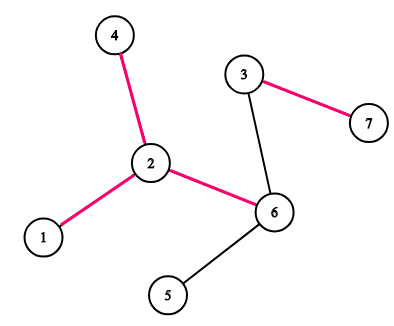Preparando MOJI
You are given a tree (a connected undirected graph without cycles) of $$$n$$$ vertices. Each of the $$$n - 1$$$ edges of the tree is colored in either black or red.
You are also given an integer $$$k$$$. Consider sequences of $$$k$$$ vertices. Let's call a sequence $$$[a_1, a_2, \ldots, a_k]$$$ good if it satisfies the following criterion:

Consider the tree on the picture. If $$$k=3$$$ then the following sequences are good: $$$[1, 4, 7]$$$, $$$[5, 5, 3]$$$ and $$$[2, 3, 7]$$$. The following sequences are not good: $$$[1, 4, 6]$$$, $$$[5, 5, 5]$$$, $$$[3, 7, 3]$$$.
There are $$$n^k$$$ sequences of vertices, count how many of them are good. Since this number can be quite large, print it modulo $$$10^9+7$$$.
The first line contains two integers $$$n$$$ and $$$k$$$ ($$$2 \le n \le 10^5$$$, $$$2 \le k \le 100$$$), the size of the tree and the length of the vertex sequence.
Each of the next $$$n - 1$$$ lines contains three integers $$$u_i$$$, $$$v_i$$$ and $$$x_i$$$ ($$$1 \le u_i, v_i \le n$$$, $$$x_i \in \{0, 1\}$$$), where $$$u_i$$$ and $$$v_i$$$ denote the endpoints of the corresponding edge and $$$x_i$$$ is the color of this edge ($$$0$$$ denotes red edge and $$$1$$$ denotes black edge).
Print the number of good sequences modulo $$$10^9 + 7$$$.
4 4 1 2 1 2 3 1 3 4 1
252
4 6 1 2 0 1 3 0 1 4 0
0
3 5 1 2 1 2 3 0
210
In the first example, all sequences ($$$4^4$$$) of length $$$4$$$ except the following are good:
In the second example, all edges are red, hence there aren't any good sequences.